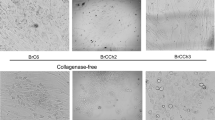Abstract
We recently established a cell line derived from pleural effusion from a 13-year-old girl with primary alveolar rhabdomyosarcoma (RMS with a chromosomal translocation t[2;13]) in the breast tissue. The cell line was designated as HUMEMS. Cases of primary alveolar RMS swelling in the breast are extremely rare (about 0.2% of all RMSs). Therefore, the HUMEMS cell line is an important material for studying therapeutics for malignant tumors in children. The HUMEMS cell line we isolated consisted of two morphological subtypes. One type (SSN cells) is small in size and has a single nucleus. Another (LMN cells) is large in size and has two or more nuclei. Both SSN cells and LMN cells were immunohistochemically positive for desmin and slightly positive for myoglobin. Our data suggested LMN cells are well-differentiated SSN cells. Moreover, in some of the LMN cells, rapid cell contractions (1–5 times/10 sec) were observed. We investigated the anticancer drug susceptibility of the HUMEMS cell line with an oxygen electrode apparatus (Daikin, DOX-10, JPN) and effect of all-trans-retinoic acid (atRA) to the cell line. The atRA-treatment inhibited proliferation of the HUMEMS cells.
Similar content being viewed by others
References
Crist WM, Garnsey L, Beltangady MS et al. Prognosis in children with rhabdomyosarcoma: a report of the intergroup rhabdomyosarcoma studies I and II. Intergroup Rhabdomyosarcoma Committee. J Clin Oncol 1990; 8: 1768–9.
Hays DM, Donaldson SS, Shimada H et al. Primary and metastatic rhabdomyosarcoma in the breast: neoplasms of adolescent females, a report from the Intergroup Rhabdomyosarcoma Study. Med Pediatr Oncol 1997; 29: 181–9.
Raney RB, Anderson JR, Barr FG et al. Rhabdomyosarcoma and differentiated sarcoma in the first two decades of life: a selective review of intergroup rhabdomyosarcoma Study Group experience and rationale for Intergroup Rhabdomyosarcoma Study V. J Pediatr Hematol Oncol 2001; 23: 215–20.
Barr FG, Galili N, Holick J et al. Rearrangement of the PAX3 paired box gene in the paediatric solid tumour alveolar rhabdomyosarcoma. Nat Genet 1993; 3: 113–17.
Nanni P, Schiaffino S, De Giovanni C et al. RMZ: a new cell line from a human alveolar rhabdomyosarcoma. In vitro expression of embryonic myosin. Br J Cancer 1986; 54: 1009–14.
Hazelton BJ, Houghton JA, Parham DM et al. Characterization of cell lines derived from xenografts of childhood rhabdomyosarcoma. Cancer Res 1987; 47: 4501–7.
Crouch GD, Helman LJ. All-trans-retinoic acid inhibits the growth of human rhabdomyosarcoma cell lines. Cancer Res 1991; 51: 4882–7.
Ogose A, Motoyama T, Hotta T et al. In vitro differentiation and proliferation in a newly established human rhabdomyosarcoma cell line. Virchows Arch 1995; 426: 385–91.
Nogi H, Kobayashi T, Kawase K et al. Primary rhabdomyosarcoma of the breast in a 13-year-old girl: report of a case. Surg Today 2007; 37: 38–42.
Amano Y, Okumura C, Yoshida M et al. Measuring respiration of cultured cell with oxygen electrode as a metabolic indicator for drug screening. Hum Cell 1999; 12: 3–10.
Uesu K, Ishikawa H. Analysis of susceptibility test of anti-cancer drugs using new types of oxygen electrodes. Bull Edu Res, Nihon Univ Sch Dent Matsudo 2002; 1: 102–15 (in Japanese).
Uesu K, Ishikawa H. Analysis of an in vitro susceptibility test of anticancer drugs using new types of oxygen electrodes. Bull Edu Res, Nihon Univ Sch Dent Matsudo 2005; 7: 7–21 (in Japanese).
Lazarides E, Hubbard BD. Immunological characterization of the subunit of the 100A filaments from muscle cells. Proc Natl Acad Sci USA 1976; 73: 4344–8.
Newton WA, Soule EH, Hamoudi AB et al. Histopathology of childhood sarcomas. Intergroup Rhabdomyosarcoma Studies I and II: clinicopathologic correlation. J Clin Oncol 1988; 6: 67–75.
Maurer HM, Beltangady M, Gehan E et al. The Intergroup Rhabdomyosarcoma Study-I: a final report. Cancer 1988; 61: 209–20.
Maurer HM, Gehan EA, Beltangady M et al. The Intergroup Rhabdomyosarcoma Study II. Cancer 1993; 71: 1904–22.
Seitz G, Warmann SW, Vokuhl CO et al. Effect of standard chemotherapy on tumor growth and regulation of multidrug resistance genes and proteins in childhood rhabdomyosarcoma. Pediatr Surg Int 2007; 23: 431–9.
Author information
Authors and Affiliations
Corresponding author
Rights and permissions
About this article
Cite this article
Ohi, S. Characterization, anticancer drug susceptibility and atRA-induced growth inhibition of a novel cell line (HUMEMS) established from pleural effusion of alveolar rhabdomyosarcoma of breast tissue. Hum Cell 20, 39–51 (2007). https://doi.org/10.1111/j.1749-0774.2007.00029.x
Received:
Accepted:
Published:
Issue Date:
DOI: https://doi.org/10.1111/j.1749-0774.2007.00029.x




